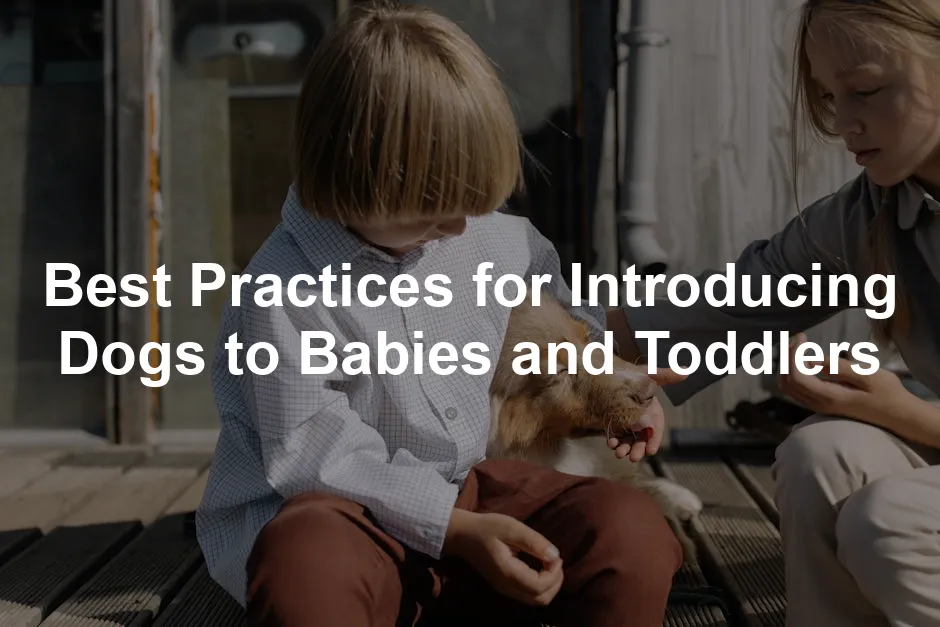Introduction
Bringing a new baby into the family is thrilling. But what about your furry friend? Integrating dogs into homes with newborns or toddlers requires careful planning. It’s crucial to manage dog-baby interactions for everyone’s safety and comfort. After all, you wouldn’t want a nip from a jealous pup ruining those precious family moments!
The journey of introducing dogs to babies isn’t just about making nice; it’s about creating harmonious relationships. This section will walk you through best practices, essential preparation steps, and handy tips for a successful introduction. Think of it as your guide to ensuring both your baby and pooch feel loved and secure. So grab a cup of coffee (or tea, if that’s your thing) and let’s dive in!

Speaking of preparation, have you considered how you’ll carry your little one while keeping your hands free? A Baby Carrier Wrap can be a game changer, allowing you to multitask while keeping your baby close. Plus, it’s a great way to bond with your little one while managing your furry friend!
Understanding Your Dog’s Behavior
The Importance of Canine Socialization
Socialization plays a starring role in shaping your dog’s behavior and temperament. A well-socialized dog is generally calmer and more adaptable. But what if your dog hasn’t had much experience with babies? Their reactions may vary based on past encounters. A dog that’s been around kids might be all tail wags and slobbery kisses, while another could be more apprehensive.
Understanding your dog’s personality is key. If they’re skittish or overly excited, that’s a red flag. Get to know their quirks and comfort levels with new experiences. Keeping this in mind can help you navigate the introduction process more smoothly. Remember, patience is your best friend here!
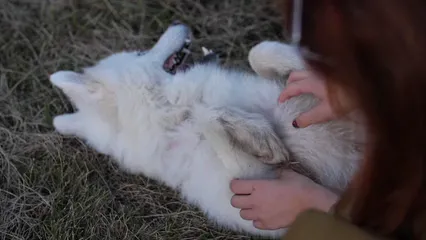
While you’re getting to know your dog’s personality, why not make training a little more fun? A Pet Training Clicker can help reinforce good behavior and make training sessions more engaging! It’s like giving your dog a little “high five” every time they do something right.
Recognizing Stress Signs in Dogs
Dogs communicate their feelings through body language. Knowing the signs of stress or anxiety can save the day. Common signs include panting, pacing, and avoiding eye contact. If your pup suddenly becomes clingy or seeks out a hiding spot, they’re likely feeling overwhelmed.
During interactions with your baby, keep an eye out for these cues. If your dog seems uneasy, it’s time to take a step back. Creating a calm environment is essential for both your dog and your little one. Awareness is not just about keeping peace; it’s about ensuring everyone feels safe and secure.

To help ease your dog’s anxiety, consider investing in a Dog Bed that provides a cozy retreat. A soft, comfortable space can help your dog feel secure and relaxed, especially during those busy family moments.
Preparing Your Dog for a New Baby
Gradual Changes to Routine
Adjusting Daily Routines
Your dog thrives on routine. So, before your little bundle of joy arrives, start adjusting your dog’s daily schedule. This means changing feeding times, walk durations, and play sessions gradually. It’s like training for a marathon; you don’t just wake up and run 26.2 miles. You build up to it!
Begin altering your dog’s routine about a month before the baby arrives. If your pup typically eats at 6 PM, shift it to 5:30 PM one week, then to 5 PM the next week. Small adjustments help your dog adapt without associating new routines with the baby’s arrival.
Also, start reducing the amount of attention and playtime you give your dog. This isn’t about neglecting them; it’s about helping them adjust to receiving slightly less attention when the baby comes home. You might think, “Isn’t this a bit mean?” Not at all! This way, your dog won’t feel shocked when your attention is divided.
Less playtime now means fewer meltdowns later when the baby needs your focus. This gradual change is your pup’s way of getting a sneak peek at the new normal. It’s all about making them feel like they’re still a cherished part of the family.

To make bath time easier for both you and your baby, consider a Baby Bath Support. It provides a safe and comfortable way to bathe your baby, ensuring they stay secure while you juggle everything else.
Acclimating to Baby Noises and Smells
Familiarizing with Baby Sounds
Let’s face it: babies can be noisy! From coos to cries, your dog needs to get used to these new sounds. A great way to prepare is by playing recordings of baby noises at home. Start with low volume during playtime or while they’re eating. Gradually increase the volume over time.
This helps your dog associate these unusual sounds with positive experiences. It’s like getting used to your neighbor’s new heavy metal band. At first, it’s jarring, but eventually, you learn to live with it (or at least tolerate it).
If your dog shows signs of anxiety, lower the volume and take it slow. Patience is key! Soon enough, those baby sounds will be just another part of the household symphony.
Introducing Baby Smells
The scent of a newborn is a unique blend of baby lotion, powder, and maybe a hint of spit-up. To help your dog become familiar with these new aromas, start by introducing baby lotions or powders into your routine.
Rub some baby lotion on your hands and give your dog a little sniff. It’s like a spa day for them! You can also ask friends with babies for unwashed baby clothes. Bring these items home and let your dog explore them.
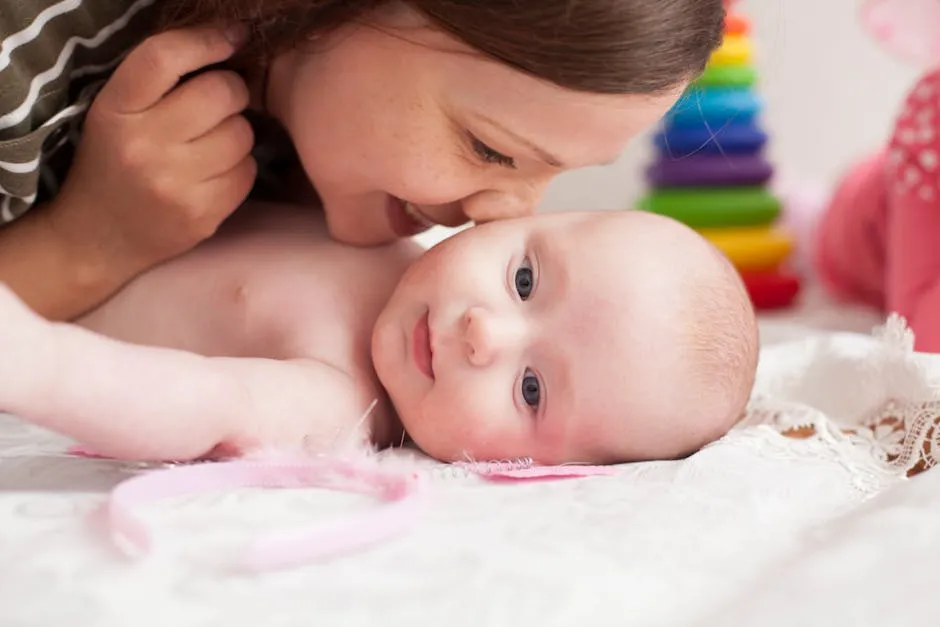
And while you’re exploring baby items, don’t forget about your pup! A Dog Grooming Kit can help keep their fur clean and healthy, making them feel great during this transition. Plus, it’s a fun bonding activity!
Setting Up Baby Equipment
Gradual Introduction of Baby Items
Introducing baby furniture and toys is a delicate dance. You don’t want to overwhelm your dog with a sudden influx of new items. Start slow, like a tortoise in a race—no need for speed here! Begin setting up baby gear a month or so before the big arrival. One day, it’s a crib in the corner; the next, a high chair.
Let your dog sniff and explore each item at their own pace. This approach helps them build a positive association with the new additions. Think of it as a sneak peek into the baby’s world. Celebrate their curiosity with praise and treats.
If your dog shows interest, reward them! This creates a bond between the baby items and good vibes. However, if they seem anxious or disinterested, take a step back. It’s all about respecting their comfort zone.
By the time the baby arrives, your dog will feel like a seasoned pro, ready to welcome the newest family member. Remember, the goal is a happy home, not a chaotic one!
When it comes to keeping baby items organized, a Baby Diaper Bag is essential. It keeps everything you need for your baby in one place, making outings with both your baby and pup a breeze!
Establishing Boundaries
Rules and Restrictions
Setting boundaries is crucial for a harmonious household. Just like we have rules at home, your dog needs them too, especially with a new baby on the way. Start by determining areas your dog will not access, like the nursery. If the baby’s room is off-limits, establish this rule well before the arrival.
Consistency is key! If your dog is allowed in the nursery now, they’ll be confused later. Use baby gates to reinforce these boundaries. It’s like creating a VIP area for your little one—no dogs allowed!
Communicate these changes to your pup clearly. Use commands they already know, like “stay” or “go to place.” Always reward good behavior when they respect the boundaries. This builds a sense of security and understanding for your dog.
Over time, they’ll learn that the nursery is a special space for the baby, not them. With clear rules and loving guidance, your dog will adjust beautifully, ensuring a safe space for everyone in the family.

And speaking of boundaries, consider a Baby Safety Gate. It’s a simple way to keep your dog away from certain areas, ensuring your baby’s space remains safe and secure.
Step-by-Step Introduction
Introducing your furry friend to a new baby can feel like a high-stakes game. But fear not! With a solid plan, you can manage this transition smoothly. Here’s a step-by-step guide to help you introduce your dog to your baby safely.
Start by keeping your dog leashed during those initial encounters. This helps prevent any sudden jumps or enthusiastic greetings that could overwhelm your little one. Think of it as a safety precaution—a bit like wearing a seatbelt!
Next, allow your dog to sniff the baby from a safe distance. Position the baby in a secure setting, like a crib or car seat, where your dog can’t reach. This way, your dog gets a whiff of the newest family member without the chance of an accidental poke or prod. It’s a win-win situation.
While this is happening, closely monitor your dog’s body language and reactions. Watch for signs of excitement, anxiety, or curiosity. A wagging tail usually means happy vibes, while a tucked tail or stiff body can signal discomfort. If your dog seems uneasy, don’t push it. Instead, take a step back and give them some space to process this new addition.
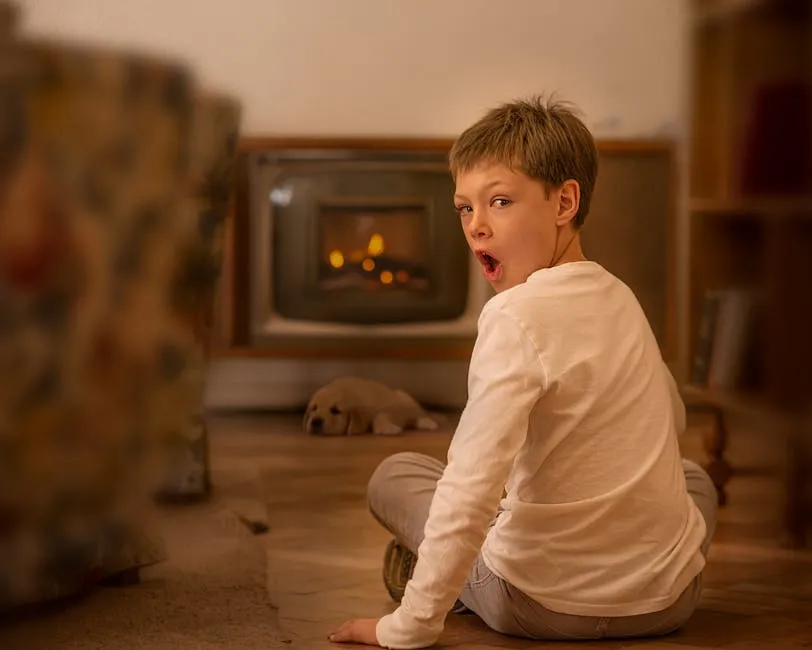
As you navigate these first interactions, don’t forget that a Dog Leash with Reflective Safety is a smart choice. It keeps your dog secure while ensuring you’re visible during evening walks. Safety first, right?
Repeat this process over several days. Gradual exposure is key! Each time, allow your dog to sniff closer, but keep that leash handy. This helps your pup feel more at ease, knowing that they can approach the baby on their own terms. It’s about building trust and comfort.
Remember, patience is essential. It might take a few tries before your dog feels comfortable with the baby. Each positive interaction strengthens their bond. Celebrate small victories with praise and treats, reinforcing calm behavior around the baby. Your dog will appreciate the encouragement!
Ongoing Monitoring and Supervision
Safety should always be your top priority. Never leave your dog and baby unsupervised, even for a moment. Accidents can happen in the blink of an eye. It’s crucial to maintain vigilant supervision during all interactions.
Consider using baby gates and management tools to create safe zones. Gates can help keep your dog out of the nursery or other areas where the baby will spend time. This way, your dog can watch from a distance without getting too close for comfort. It’s like giving both your pup and baby their own safe spaces.
Additionally, set up a designated area for your dog to retreat to when things get too busy. This could be a cozy crate or a quiet room where your dog can relax. Think of it as their personal hideaway, away from the hustle and bustle of family life.
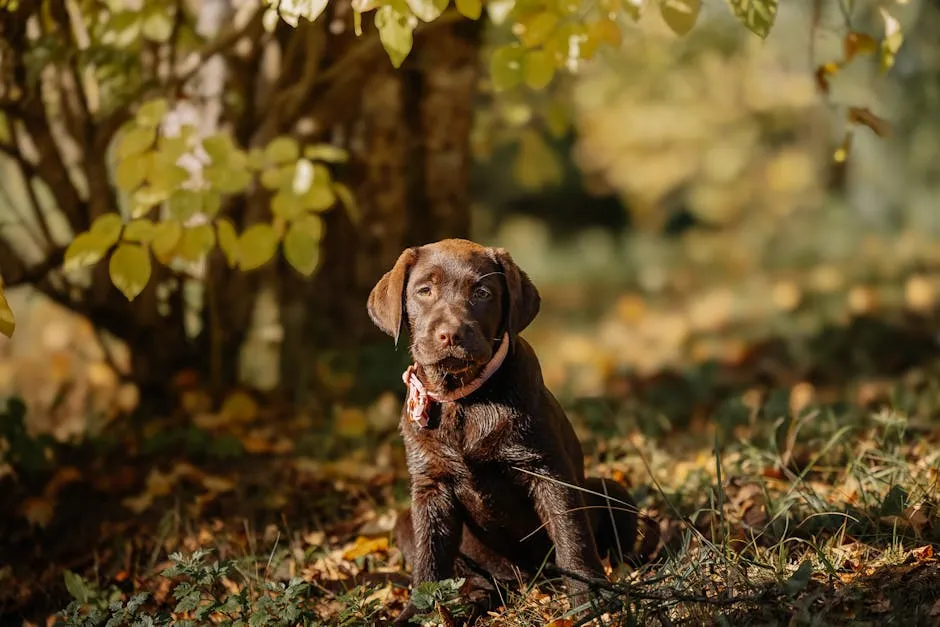
For those busy moments when you need to keep your dog secured, a Dog Crate for Training can be a lifesaver. It offers a safe space for your dog while you attend to the baby, ensuring everyone is comfortable.
Encouraging Positive Interactions
Reward-based Training
Using reward-based training is a fantastic way to encourage positive interactions between your dog and baby. By reinforcing calm behavior with treats and praise, you’re establishing a solid foundation for your dog to build on.
Start by rewarding your dog when they demonstrate calmness around the baby. If they sit quietly or simply observe, offer treats! This teaches your dog that good things happen when they stay composed. It’s like giving them a gold star for being a good pup.
You can also incorporate training sessions focused on commands like “sit,” “stay,” or “gentle.” These cues become invaluable when the baby starts to move and explore. Teaching your dog to respond to these commands helps ensure everyone’s safety during interactions.
As your baby grows, continue to reinforce positive behavior. If your dog remains calm while the baby is crawling or playing, shower them with praise. This creates a positive association with the baby’s presence.

And speaking of rewards, why not enhance your training sessions with some tasty treats? A pack of Dog Treats for Training can make your sessions even more engaging! They’ll love working for these delicious rewards.
Facilitating Bonding Over Time
Gradual Increase in Interaction
As your baby grows, it’s time to up the ante on those interactions with your furry friend. Start by observing your baby’s movements. Once they’re crawling, your dog will need to adjust to this new level of mobility. Babies tend to be curious and may reach out to your pup, which can be both adorable and a little chaotic!
Begin with short, supervised play sessions. Allow your baby to interact with your dog while you’re right there. This way, you can monitor the situation and ensure everyone is safe. When your baby giggles and reaches for your dog’s soft fur, it’s heartwarming. But keep in mind, your dog might not appreciate tiny fingers tugging at their ears!
Encourage gentle touches by guiding your baby’s hands. Show them how to pet softly, reinforcing this behavior with praise. You might say, “Good job, sweetie!” while your dog enjoys the attention. This creates a positive experience for both parties and helps your dog feel more at ease.
As your baby grows and becomes more mobile, allow more freedom in their interactions. Your dog will begin to understand that this tiny human is now part of the family. It’s all about building trust and familiarity!
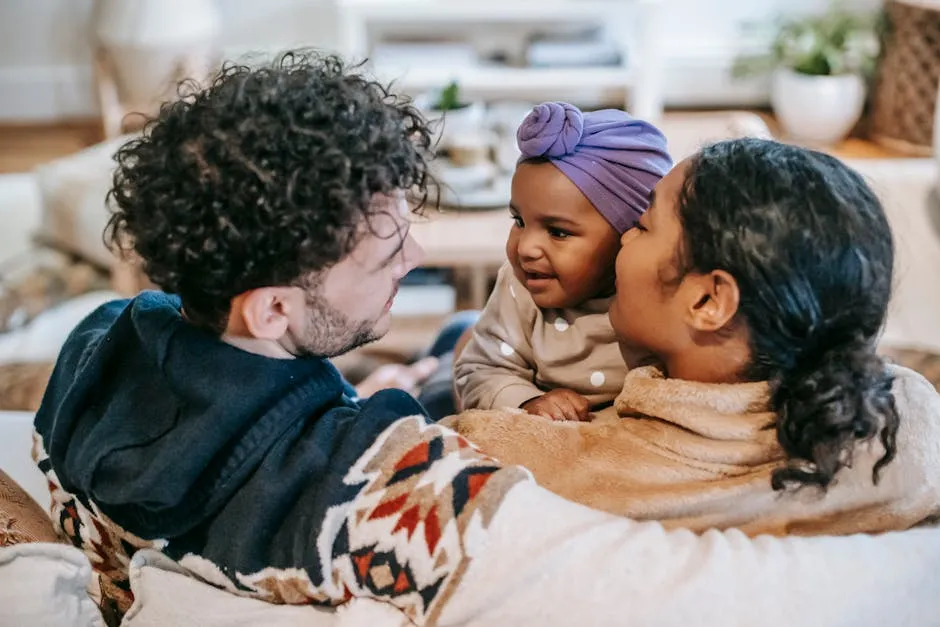
And don’t forget about playtime! An Interactive Dog Toy can keep your pup entertained while your baby plays nearby. It’s a great way to ensure your dog stays engaged while everyone learns to coexist!
Incorporate playtime into family activities, ensuring both your baby and dog are included. Whether it’s a game of fetch or a quiet cuddle session, these moments will strengthen their bond. Remember to keep an eye on body language. If your dog seems overwhelmed, give them a break.
With patience and gradual exposure, your dog and baby can develop a delightful friendship. Let the bonding begin!
Conclusion
Introducing dogs to babies requires a thoughtful approach. Start with gradual changes to routines and environments. Prepare your dog for the new arrival by familiarizing them with baby scents and sounds. Always supervise interactions, ensuring safety for both your little one and furry friend.
Establish boundaries to help your dog understand their new place in the family. Allow them to adjust to the sight of baby items and the sounds that come with a newborn. With patience and proactive planning, your dog and baby can coexist harmoniously.
Don’t hesitate to reach out for professional help if you have concerns about your dog’s behavior. Experts can provide guidance tailored to your unique situation. By taking the time to prepare, you can ensure a loving atmosphere where both your dog and baby thrive.
FAQs
What if my dog has aggression issues?
If your dog has aggression issues, it’s crucial to consult a professional trainer or behaviorist. They can assess your dog’s behavior and create a customized plan to address the aggression. This step is vital to ensure safety during introductions and interactions with your baby. Never take chances with an aggressive dog; prioritize safety for everyone involved.
How long should I wait before introducing my dog to my newborn?
The timing of the introduction depends on your dog’s temperament and their previous exposure to children. Generally, waiting a few days after bringing your baby home is advisable. This allows your dog to adjust to the changes in the household. Each dog is unique; adjust the timing based on how your dog reacts to the new environment.
Can my dog feel jealousy after the baby arrives?
Yes, dogs can experience jealousy when a new baby arrives. To manage this, provide plenty of attention and affection to your dog, even when the baby is present. Establish a structured routine that includes dedicated time for your dog. This helps prevent feelings of neglect and ensures they still feel like a cherished family member.
How can I ensure my dog feels included after the baby arrives?
Incorporate your dog into family activities as much as possible. Use baby naptime to engage in quality playtime with your dog. Encourage gentle interactions, rewarding calm behavior with treats and praise. Maintaining a regular schedule for walks and playtime helps your dog feel secure and included in the family dynamic.
Please let us know what you think about our content by leaving a comment down below!
Thank you for reading till here 🙂
All images from Pexels

